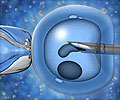The risks of complications both during and after pregnancy achieved through assisted reproduction techniques (ART) are significantly higher than for natural conception.
The risks of complications both during and after pregnancy achieved through assisted reproduction techniques (ART) are significantly higher than for natural conception, and long term follow-up of children born through ART is needed to fully understand the consequences of these techniques. The issues are addressed in a Review published in this week's edition of The Lancet.
Dr Alastair Sutcliffe, Institute of Child Health, University College London, UK and Dr Michael Ludwig, Endokrinologikum, Hamburg, Germany reviewed data published between 1980 and 2005 on in-vitro fertilisation (IVF) and intracytoplasmic sperm injection, and used 3980 articles to compile their analysis. They focussed mainly on ART single births, since multiple births bring with them their own set of confounding complications.The authors say: “In-vitro fertilisation has been done for nearly 30 years; in developed countries at least 1% of births are from ARTs. These children now represent a substantial portion of the population but little is known about their health."
They say that there are several points for consideration when counselling couples seeking treatment for subfertility. The biggest risk for ART is that multiple births may occur, however a number of other risks are evident from ART techniques.
Spontaneous abortion rates are between 20-34% higher for ART couples compared to those spontaneously conceiving -- this could be because ART couples are generally older, and also due to endocrine disorders, organic abnormalities and the degree of ovarian stimulation. For couples using ART, the risk of pre-eclampsia occurring is increased by 55%, while there is also an increased risk of still birth (155%), low birthweight (70-77%) very low birthweight (170-200%), or the baby being small for gestational age (40-60% increased risk).
Risk of major malformations is 30% higher in babies born to ART couples, regardless of ART technique (although the absolute risk is still small), and there is also a higher risk of cerebral palsy in children born to ART couples, partly because of the risk associate with increased premature birth and partly because some twin pregnancies undergo early in-utero loss, and this event is associated with an enhanced risk of cerebral palsy. The risk of cerebral palsy is lower if single-embryo transfer, rather than multiple-embryo transfer, takes place during the ART.
However neurodevelopmentally, mature term babies born after ART progress healthily in relation to naturally conceived children, and no concerns exist about family relationships and psychological issues after ART conception.
Advertisement
"Long term follow-up of children born after ART to reproductive age and beyond is necessary."
Advertisement
SRM/C






